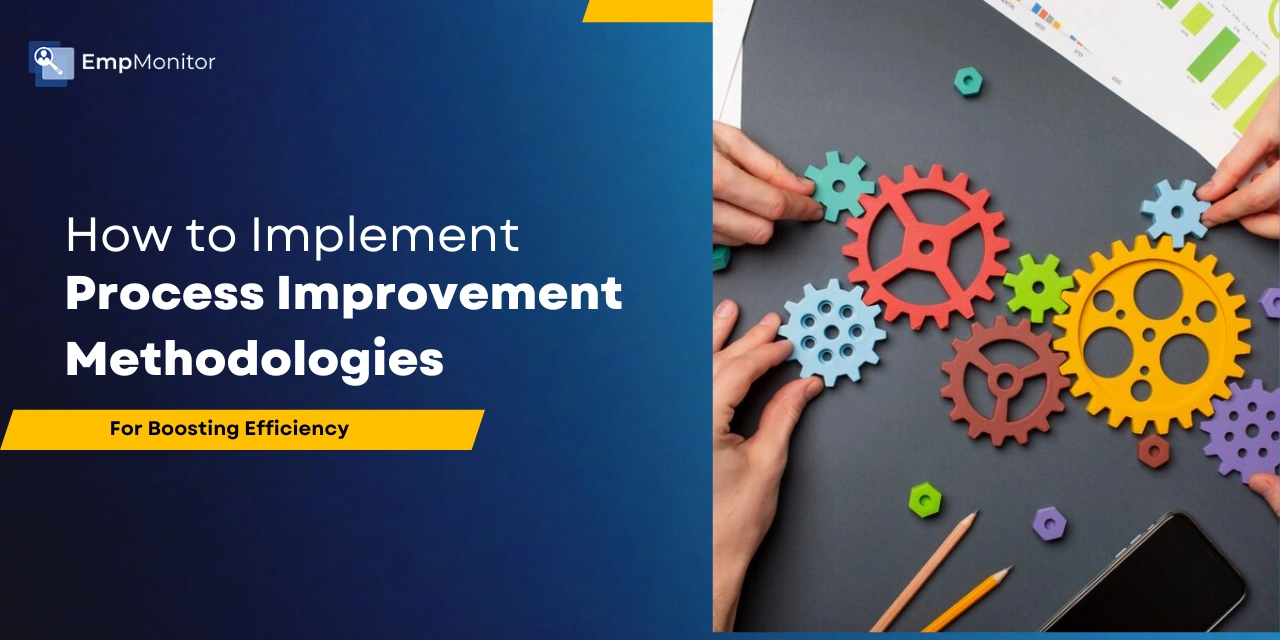Looking to improve your business operations, cut costs, and boost customer satisfaction? The continuous improvement process can help you do just that.
Continuous process improvement is all about making small, consistent changes that lead to big results. It helps businesses stay competitive, efficient, and adaptable. Companies can identify and address inefficiencies by regularly refining processes before they become bigger problems.
In this blog, we’ll explain the continuous improvement process, why it’s crucial for success, and how you can start using it today.
In a hurry? Listen to the blog instead!
What Is Process Improvement in Business?
Process improvement is the practice of analyzing, optimizing, and refining business processes to increase efficiency, reduce waste, and improve overall performance. It involves identifying areas where workflows or operations are inefficient, making changes to enhance them, and continuously monitoring for further improvements.
The goal of business process improvement is to streamline tasks, save time, lower costs, and boost quality, leading to better customer satisfaction and smoother operations. To take your process optimization to the next level, integrate EmpMonitor’s workforce management software and experience unparalleled efficiency and control.
Importance Of Improving Processes
Every business runs its operations on a variety of business procedures. Everything your company does, including hiring new employees, processing payments, and fixing problems with IT systems, has a procedure.
Your business operations are probably suffering from a process breakdown if your business procedures take a long time to finish, use more resources than anticipated, or yield inconsistent outcomes. Erroneous or inefficient procedures can cost companies $1 trillion a year. Process enhancements can take care of that.
Process Improvement Benefits
The goals of improving processes often include enhancing productivity, gaining agility or visibility to respond to market changes, streamlining workflows, boosting profits, addressing security vulnerabilities, achieving operational excellence, or improving user experiences both internally and externally.
Here’s how improving process can benefit your business:
- Enhanced Results: Process improvements lead to better outcomes, such as improved employee performance and clearer process milestones.
- Time Savings: By streamlining tasks and reducing steps, improving processes decreases the time required to complete tasks.
- Increased Transparency and Alignment: Clearly defined processes ensure team members understand their roles and responsibilities, facilitating better information sharing and collaboration.
- Improved Customer Satisfaction: Faster and more effective service, consistent quality, and meeting deadlines are achievable through improving processes, and enhancing customer experiences.
- Reduced Waste: Eliminating redundant steps or unnecessary processes helps minimize wasted time and resources, making operations more cost-effective.
7 Effective Process Improvement Methodologies For Boosting Efficiency
improving processes is essential for businesses aiming to reduce inefficiencies and streamline operations. There are seven key methodologies that your team can adopt, each suited for different objectives and challenges. The right approach will depend on your goals and the areas where you’re looking to improve. Let’s dive into these strategies for improving the process.
1. Lean Manufacturing
Lean manufacturing, also known as Lean production or just-in-time production, focuses on reducing waste and maximizing value. Developed by James P. Womack, Daniel Jones, and Daniel Roos, this method was inspired by Toyota’s manufacturing principles.
The five core principles of Lean include:
- Identify value from the customer’s perspective.
- Map the value stream to eliminate wasteful steps.
- Create flow to ensure smooth processes.
- Establish pull, producing only what is needed.
- Pursue continuous improvement for long-term optimization.
Lean is widely used in manufacturing, but its principles can be applied across industries to increase efficiency by eliminating non-value-adding activities.
2. Six Sigma Methodology
Six Sigma is a process improvement approach focused on reducing variations and defects. This method, introduced by Bill Smith at Motorola, aims to improve consistency in production by minimizing defects to fewer than 3.4 per one million opportunities. Six Sigma uses statistical benchmarks to measure process performance.
The DMAIC process (Define, Measure, Analyze, Improve, Control) is commonly used to improve existing processes. It identifies areas of inefficiency, analyzes root causes, and implements solutions to optimize performance.
3. Business Process Management (BPM)
Business Process Management (BPM) is a holistic approach to improving business efficiency by analyzing, redesigning, and continuously optimizing workflows. This workflow process management helps identify bottlenecks, automate repetitive tasks, and refine business processes as the organization grows.
The key steps in BPM include:
- Analyze current processes through mapping.
- Model an improved version of the process.
- Implement the improved process.
- Monitor key metrics to measure success.
- Optimize continuously by refining processes.
BPM helps businesses adapt to growth and improve overall efficiency.
4. Plan-Do-Check-Act (PDCA)
The PDCA cycle, developed by Walter Shewhart and popularized by W. Edwards Deming, is an iterative methodology. It involves four key steps:
- Plan: Identify the problem and create a solution strategy.
- Do: Implement the solution on a small scale.
- Check: Evaluate the results of the test.
- Act: Decide whether to apply the solution at a larger scale.
PDCA is a cyclical process that can be repeated until the desired outcome is achieved. It’s widely used for quality control and continuous process improvement across industries.
5. Continuous Improvement (Kaizen)
Kaizen, a Japanese philosophy, revolves around continuous, incremental improvements. The goal of Kaizen is to enhance productivity by eliminating waste and inefficiencies. This methodology focuses on:
- Muda (waste): Activities that don’t add value.
- Mura (unevenness): Overproduction or excess inventory.
- Muri (overburden): Strain on resources, whether it’s machinery or personnel.
By consistently making small improvements, businesses can optimize processes, enhance product quality, and create a culture of continuous growth.
6. Total Quality Management (TQM)
Total Quality Management (TQM) emphasizes improving the quality of processes to boost customer satisfaction. This customer-centric approach involves every department and employee in the process improvement effort.
Key features of TQM include:
- Customer focus: All improvements are made with the end customer in mind.
- Full-team involvement: Every department works towards improving processes, not just production teams.
- Continuous improvement: Small, ongoing changes aim for long-term optimization.
- Data-driven decision making: Performance metrics guide process improvements.
TQM is often employed in supply chain management and product development to enhance quality and reduce inefficiencies.
7. 5 Whys Analysis
The 5 Whys method is a simple yet effective process improvement tool for uncovering the root cause of problems. By asking “Why?” repeatedly- typically five times- teams can drill down into the underlying issue.
For example, if a product was damaged during shipping, the first “Why?” may reveal insufficient packaging. Asking further “Whys?” may eventually uncover that the packaging design didn’t account for the new product dimensions, leading to the problem. This method helps teams identify process inefficiencies without placing blame on individuals.
Choosing the right methodology for improving processes is crucial for businesses seeking to reduce inefficiencies and optimize performance. From Lean manufacturing’s focus on waste reduction to Six Sigma’s emphasis on minimizing defects, each methodology offers unique benefits.
By adopting one or more of these approaches, your team can enhance productivity, improve quality, and drive long-term success.
Adopt the right strategy for your organization and see the transformation in efficiency and productivity.
Read More:
9 Workforce Optimization Strategies To Know This Year
8 Reasons Your Company Needs A Workflow Management System
Ways To Improve A Process
Here’s a guide on how to improve a process efficiently, using process improvement methodologies:
1. Analyze the Impact of the Problem
Before jumping to solutions, assess how the existing process issues affect your team or organization. Analyze the data and use reporting tools to measure the scope of the problem. This step is critical to ensure that process improvements address the most significant pain points.
2. Identify the Process Needing Improvement
Once you understand the core issue, identify which processes are causing the problem. Focus on the specific workflows or systems that are leading to delays, miscommunication, or inefficiencies. Targeting the right process is essential for impactful process improvement.
3. Communicate Changes Effectively
Once improvements are set, it’s essential to keep the team informed. Clear communication about the changes, new procedures, and expectations will ensure everyone is aligned and knows their role in the updated process.
4. Create Standards and Procedures
Standardization is key to sustainable process improvement. Set clear guidelines for how processes should be followed and create a map to avoid any confusion. This also includes setting a regular schedule to review and assess the effectiveness of the improvements.
5. Involve the Whole Team in Solution Development
The continuous improvement process works best as a team effort. Engage all stakeholders in brainstorming potential solutions and mapping out workflows. This collaborative approach helps ensure that the improvements are practical and that the entire team is on board.
6. Implement The Improvements
Once you have identified the problem, analyzed the data, and gathered team input, it’s time to implement the improvements. Use tools and software to assist with process mapping and execution, making sure to monitor the changes closely for initial feedback.
One tool that can streamline this process is EmpMonitor– a workforce management software designed to help businesses track tasks, manage teams, and boost productivity. Let’s explore more features of this powerful project management solution.
EmpMonitor: The Workforce Management Software
EmpMonitor is a robust employee monitoring tool that enhances workforce productivity. Trusted by over 500,000 employees in more than 100 countries across various industries, it offers:
Web Data and App Usage
Keep your eyes on what websites your employees visit and identify any possible online time stealers. PInpoint blind spots and maintain enterprise-level management with a solid framework to shield the employees’ productivity from potential app distraction.
Automatic Timesheets
EmpMonitor provides an automatic timesheet that helps in avoiding manual time entry. It automatically starts tracking time once the user starts the computer and gives accurate activity insights.
Project Management:
- Customized Access Levels: Set specific access permissions for team members to control their access and responsibilities.
- Role Assignment: Clearly define and assign roles to individuals, ensuring tasks align with their skills.
- Member Groups: Organize team members into groups to facilitate better communication and collaboration.
- Timeline Monitoring: Keep track of project timelines, documenting task progress and deadlines.
- Task and Subtask Management: Manage tasks and subtasks with full CRUD capabilities for detailed tracking and control.
Shift Management:
- Real-Time Tracking: Monitor shift schedules and attendance in real time to ensure optimal staffing.
- Efficient Scheduling: Easily handle shift changes and manage employee schedules for smooth operations.
Additional Features:
- Time Tracking: Accurately record work hours to manage billing and productivity.
- User Activity Monitoring: Track employee computer activity to assess performance and ensure security.
- Insider Threat Prevention: Implement strategies to detect and prevent potential internal threats.
EmpMonitor’s comprehensive features ensure effective workforce management and workforce optimization.
Final Thoughts
Mastering process improvement is essential for boosting efficiency and driving business success. Start by focusing on small, impactful changes and leveraging the right technology to streamline operations. Establishing clear standards and maintaining a well-structured plan are crucial for effective implementation.
EmpMonitor can elevate your process improvement efforts by providing robust workforce management features. From tracking tasks and managing teams to enhancing productivity, EmpMonitor offers the tools you need for seamless project execution.
Thank you for reading. Try EmpMonitor today and see the difference for yourself!
Frequently Asked Questions
How can process improvement impact employee morale?
Reducing monotonous labor, streamlining workflows, and raising job satisfaction are all ways that efficient process improvement can raise employee morale. Streamlining procedures allows employees to focus more of their time on meaningful work and less time on tedious duties.
How do I involve my team in the process improvement initiative?
Encourage team members to provide input and feedback on existing processes to keep them engaged. Foster a collaborative improvement atmosphere by acknowledging their contributions, offering training, and including them in brainstorming sessions.
How can small businesses benefit from process improvement?
Process optimization can help small firms become more efficient, save money on overhead, and improve customer satisfaction. Process simplification enables them to compete more successfully and respond swiftly to changes in the market.















